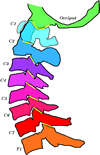
This collection of essays is related to the anatomy and movements of the lower cervical spine. The lower cervical spine is taken to include the lower part of the axis and all cervical vertebrae and intervertebral joints down to the upper part of the first thoracic vertebra. As with the upper cervical assembly essays, the emphasis is upon describing the anatomy of the lower cervical spine in a mathematical language that can then be used to make observations upon the nature of the movement between the vertebrae.
| Building a Neck [ Word | PDF ] This essay considers the basic strategy for constructing a model of the lower cervical spine. It is introductory to this series of essays. It introduces much of the anatomical measurements used in constructing the model. |
|
| Lower Cervical Spine Model [ Word | PDF ] The model used in the other essays is developed in this here. It is a model expressed as Mathematica program segments. The essence of the approach is to establish representative dimensions and configurations for the cervical vertebrae and the intervertebral discs, to express the orientation of the various vertebrae when the neck is in neutral position, and express the axes of rotation for flexion/extension and oblique rotations at each vertebral level. The model allows the input of parameters for the movements in each intervertebral joint and it calculates the conformation of the neck after those movements have occurred, then expresses the result of its calculation as a three-dimensional model, using simplified elements. |
|
| Movements in an Artificial Neck [ Word | PDF ] In this essay the presentation is concerned with the consequences of concatenating the movements in the various vertebral joints. Sample sets of rotations are chosen and the consequence of their occurrence are computed. The net effect is considered as amounts of flexion/extension, sideflexion, and lateral rotation in the lower cervical spine |
|
| Centers of Rotation in the Cervical Spine [ Word | PDF ] In this essay the presentation is concerned with the consequences of concatenating the movements in the various vertebral joints. Sample sets of rotations are chosen and the consequence of their occurrence are computed. The net effect is considered as amounts of flexion/extension, sideflexion, and lateral rotation in the lower cervical spine |
|
Disc Strains. Why do we not have lumbar discs in our neck? [ Word | PDF ] The intervertebral discs are very important in determining the amount of rotation that occurs in various directions. In this essay the implications of the disc structure are considered from the point of view of how various types of movement between the cervical vertebrae would strain the intervertebral discs. It is found that the actual configuration of the cervical discs is contingent upon the types of movements that occur in the neck and vice versa. |




